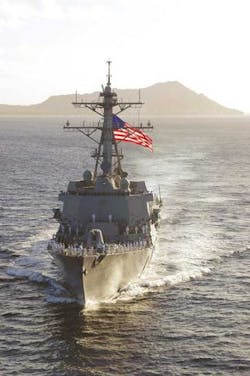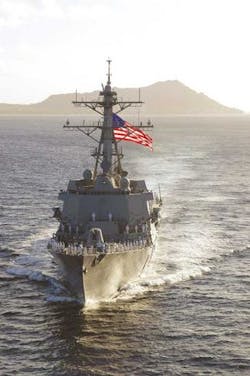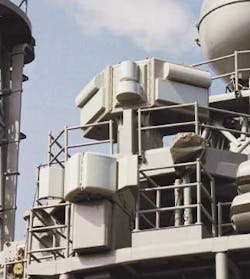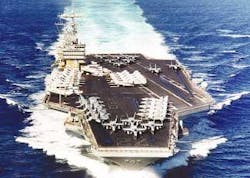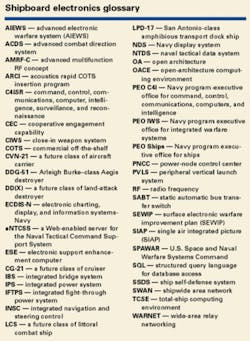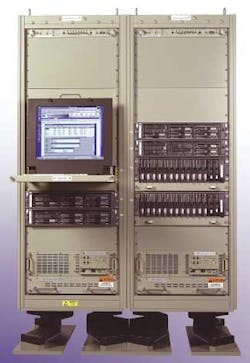Shipboard electronic systems pursue open architectures
By Edward J. Walsh
A battery of defense companies are joining forces to design a wide range of electronics for surface ships, ranging from integrated bridge systems, tabletop flat-panel displays, wide-area and wireless networking, and integrated shipboard power and propulsion systems.
Navy leaders, facing continuing budget constraints and urgent requirements for "transformation," accelerated their push over the past year to find solutions for ship systems that rely on easily upgradeable, affordable commercial electronic and optoelectronic technologies. By all accounts that effort will continue as service officials sharpen their focus on networked architectures that support great levels of integration for battle-group and joint-service operations.
The Navy's transformation campaign, encompassing operations, acquisition, training, and business practices, is outlined in the top-level strategy called Naval Power 21, which emphasizes technologies to fight, defend, and support warships and warship fighting forces at sea.
Naval Power 21 lays out three "pillars" for fleet operations: sea strike, sea shield, and sea basing, which focus respectively on offense, defense, and ship-based logistics support for Marine Corps and Army units ashore.
The transformation effort guides current shipbuilding efforts. The Navy continues to build Arleigh Burke–class (DDG-51) Aegis destroyers. In December 2003 the Navy awarded Northrop Grumman Ship Systems in Pascagoula, Miss., a $419 million contract for DDG-107 — the 57th ship of the Burke class. The company also is building four San Antonio–class (LPD-17) amphibious transport dock ships.
To support the pillars, new fleet weapon, sensor, and command, control, communications, computer, intelligence, surveillance, and reconnaissance (C4ISR) systems must be able to work tightly together, replacing stand-alone "stovepiped" systems that were designed in the 1960s and 1970s, and are still in the fleet today. Ship commanders and their combat systems will be linked through the Navy's FORCEnet information-management architecture.
Navy and industry officials say that the shift to greater emphasis on joint operations, systems interoperability, and commercial off-the-shelf (COTS)–based components acquisition will require fundamental rethinking of current Navy management practices and operational concepts and doctrine and, they point out, will not represent a smooth road. The Navy's new vision for combat-systems interoperability, called "Open Architecture," follows two earlier initiatives — Sea Athena and "common command and decision" — that started in the 1990s but failed to gain support.
The Navy's Open Architecture initiative — OA for short — comes under management of the program executive office for integrated warfare systems — otherwise known as PEO IWS. It aims at developing an open-architecture computing environment (OACE) that will serve as the technical architecture for a common combat system for today's surface combatants, aircraft carriers, and big-deck amphibious ships.
The OA environment also will be part of future ships, including the DD(X) land-attack destroyer, a littoral combat ship (LCS) now in development, a next-generation aircraft carrier (CVN-21) and a future cruiser or CG-21.
Navy Capt. Tom Strei, director for architectures for PEO IWS, says the OA effort, which comes under joint management of the PEO IWS and the program executive office for command, control, communications, computers, and intelligence (PEO C4I), will build on breakthroughs in commercial telecommunications and processing that can be integrated to permit high-speed data connectivity, even for time-critical combat systems. "It's all about data movement," he says. "We'll use technology to bring systems and applications together."
Traditionally, the Navy shipboard combat systems build around Navy-unique hardware and software considered essential for combat operations. Navy leaders have relied on custom-built hardware to provide fail-safe performance required for the life-or-death weapons-engagement sequence when there is no margin for error. The Navy's proprietary UYK family of shipboard computers long built by Lockheed Martin is expensive to modify and cannot provide the processing speed possible with new commercially developed processors.
No longer affordable
Strei points out that the Navy's cruiser, destroyer, carrier, and amphibious-ship program offices have for years developed all the functionality for their individual combat systems — even though system functions such as timing, navigation, combat identification, track formation, and track management are common across all ship types. Even if the combat system of one ship class is "open," it would not be compatible with the same system built for another class. That practice no is longer affordable, he says.
Navy leaders started working toward a COTS-based architecture for the Aegis combat system aboard their Ticonderoga-class cruisers and Burke-class destroyers with baseline 6 phase 3, and extended the COTS content with new commercial processors for baseline 7 phase 1.
Still, the current level of COTS insertion for combat systems falls short of the Open Architecture plan, Strei says. For incremental COTS upgrades, systems integrators add new commercial processors, interfaces, and displays, but the fundamental architecture is a custom Navy design.
The OA effort is planned as an evolution through five categories of computing "environments." Category 1 retains long-used proprietary hardware and software but introduces some hardware interfaces to commercial processors. Category 2, now the goal of the current Aegis software development, adds open-architecture middleware and open application program interfaces, yet like Category 1 does not meet OA goals.
Strei says that Category 3, the first level of OA compliance, will be achieved by 2008 for surface combatants, carriers, amphibs, and the littoral combat ship. Category 3 will introduce the POSIX and CORBA software standards to support software reuse. It also will implement a range of Internet protocol standards and the IEEE standards for Ethernet, 802.11 wireless, and structured query language (SQL) database access.
OA Category 4 will field common combat systems functionality. Category 5, referred to as a "total ship computing environment," now being developed for the DD(X), will introduce dynamic resource management for the ship computing plant that will allow reallocation of functions among processor nodes if necessary.
A critical step on the way to a full-up OA is fielding of the newest variants of the ship self-defense system (SSDS) for aircraft carriers and the Wasp and San Antonio classes of amphibious assault ships.
The Mk 2 SSDS can be viewed as the first step toward surface-ship open architectures, says Capt. Joe McGettigan, manager of the SSDS program. The Mk 2 system has been developed in three variants by Raytheon Integrated Defense Systems in Tewksbury, Mass. An Mk 2 mod 0 SSDS is a one-of-a-kind system for the aircraft carrier USS Nimitz that retains the Navy proprietary advanced combat direction system (ACDS block 1). Mod 1 will go aboard aircraft carriers, and a mod 2 aboard the San Antonios and Wasps. In May 2003 Raytheon received a contract for five systems — one for LHD-8, the last ship of the Wasp class, one for the future aircraft carrier USS George H.W. Bush (CVN-77), and three land-based systems.
The Mk 2 SSDS, like the Aegis system, links air-defense sensors and weapons, with interfaces to C4I, identification/friend/foe, electronic warfare, and navigation systems. It also interfaces with a custom variant of the cooperative engagement capability (CEC version 2.1), which will enable SSDS ships to participate in cooperative targeting networks with other CEC ships and aircraft.
Unlike Aegis, which is built around the SPY-1 radar, the SSDS weapons and sensors — including the Phalanx close-in weapon system (CIWS), NATO Sea Sparrow missile, and rolling airframe missile, and the radars, such as the SPS-48E, SPS-49, and SPQ-9B — use their own software programs.
The systems are linked along a fiber-optic local area network through distributed processors, called LAN access units, or LAUs. The key COTS element of the system is the multi-LAU cabinet from APW Enclosure Systems in Waukesha, Wis.
This cabinet houses Motorola PowerPC microprocessors and PCI mezzanine card (PMC)-721 input/output cards; an uninterruptible power supply from ETI Ltd. in Hythe, England; and switches and PMC ATM communications interface cards from the RAMiX operation of GE Fanuc Automation in Ventura, Calif. The Titan Corp. in San Diego provides naval tactical data-system (NTDS) boards, and Folsom Research Inc. in Rancho Cordova, Calif., builds the radar interface, target extractor, and window-capture functions. Symmetricom in San Jose, Calif. — formerly Datum — provides the SSDS time-code processor.
The Mk 2 SSDS will replace an older advanced combat-direction system aboard the aircraft carriers and Wasp-class amphibs. A Mk 1 SSDS, also from Raytheon, already is installed aboard Whidbey Island-class amphibs.
The Mk 2 mod 1 has been installed on the Navy's newest aircraft carrier, the USS Ronald Reagan, and is going through shipboard testing and land-based testing at the Surface Combat Systems Center at Wallops Island, Va. The Mk 2 mod 2 has been installed on the USS San Antonio, which is under construction at the Northrop Grumman Ship Systems shipyard in New Orleans. The mod 2 is going through ship checkout and will start testing in May.
McGettigan says that to move SSDS toward OA Category 3 compliance, the program will carry out a technology refresh this year, replacing cards, switches, and other components that are becoming commercially unavailable. A second tech refresh in 2008 will get the system to full Category 3 compliance.
Cooperative engagement
For SSDS and Aegis ships, the CEC system links the sensor data from ship radars to produce a continuously updated composite of targeting data. All ships, aircraft, and ground units participating in a CEC network share the CEC composite track picture simultaneously. The CEC consists of a system-unique cooperative engagement processor, data-distribution system, and phased-array antenna.
Navy leaders have declared that CEC, which is to be installed on Ticonderoga-class Aegis cruisers, Arleigh Burke–class Aegis destroyers, aircraft carriers, big-deck amphibious ships, and E-2C Hawkeye surveillance aircraft, represents a foundation for integrated fleet air-defense and an ambitious new concept of "joint-sensor networking."
In mid-December 2003 PEO IWS leaders canceled a planned industry competition for a block 2 CEC that was expected to be a major step toward achieving "network-centric warfare," through greater battle-group and joint-force interoperability, with more commercial technology.
Raytheon Network-Centric Systems in McKinney, Texas — the Navy's block 1 CEC prime contractor — and Lockheed Martin Maritime Systems and Sensors (MSS) in Moorestown, N.J. — developer of the Aegis combat system for cruisers and destroyers — formed a team in January 2003 to compete for the new CEC contract. Other major defense companies also were expected to compete. In canceling the plan, though, Navy officials said there would be future "competitive opportunities."
Navy and industry officials say that the block 2 CEC was intended to expand joint-sensor networking capability dramatically, in part to make it more attractive to the Army and Air Force, and to serve as the foundation for a joint-service single air integrated picture (SIAP), which is considered critical for network-centric warfare. While all the services continue discussions of joint integrated air defense concepts, the Army and Air Force thus far have not bought CEC.
Raytheon continues to build the block 1 CEC system, which is going through significant COTS upgrades. At the end of 2003 the company had either delivered or had in production 93 block 1 systems. In December the Navy awarded the company a production contract for 2004, valued at $60 million, for seven shipboard USG-2 systems and two USG-3 airborne systems.
A CEC technology refresh has replaced Motorola 167 processors for the data-distribution system with Motorola PowerPC-based processors, explains Raytheon program director Pat Speak. The cooperative-engagement processor also has moved to the Motorola PowerPC-based processor. The company also has started building a new heavily COTS planar-array antenna assembly that replaces expensive unique transmit-receive modules built by Raytheon with separate transmit and receive modules based on commercial components.
In another major effort, PEO IWS will replace the current Raytheon-built shipboard SLQ-32(v) electronic warfare system with a modular COTS-based system. The surface electronic warfare improvement plan (SEWIP) replaces an advanced electronic warfare system (AIEWS) originally developed by Lockheed Martin but canceled in early 2002 because of schedule and cost shortfalls.
The deliberately paced full SEWIP, in four block upgrades, will not be complete until 2015. Block 1A, now in progress, replaces the SLQ-32 data-processing unit — a proprietary Rolm Assembly language computer — with the Navy's UYQ-70 display processor. Digital Systems Resources (acquired in September 2003 by General Dynamics Advanced Information Systems) is the SEWIP prime contractor. Northrop Grumman PRB Systems in Hollywood, Md., is providing the new electronic support enhancement (ESE) computer and ESE software.
Block 2 will replace the SLQ-32 receiver with a receiver and antenna architecture. For Block 2, PEO IWS has signed a technology transition agreement with the Office of Naval Research (ONR) in Arlington, Va., to incorporate the receiver developed for the advanced multifunction radio-frequency (RF) concept (AMRF-C), a major technology effort aimed at consolidating radar, communications, and electronic warfare apertures. Block 3, expected beyond 2012, will upgrade the RF electronic-attack architecture with an electro-optic capability. A Block 4, in the 2015 timeframe, would lead to a full-up RF and optoelectronic attack and full open architecture compliance.
In a separate effort to extend the open-architecture concept, PEO IWS in late 2003 awarded a contract to Northrop Grumman Sperry Marine in Charlottesville, Va., to act as the Navy's sole supplier of electronic charting, display, and information systems, called ECDIS-N, in a competition that rejected two Navy-developed systems. The contract calls for the company to develop an OA-compliant approach for integrating electronic charting, steering control, and ship navigation sensor suites with combat systems.
Sperry designers also won a contract last fall to provide "scalable" variants of their integrated bridge system (IBS) for as many as 170 ships, including all surface combatants, submarines, amphibious ships, and auxiliaries. The company is building an integrated navigation and steering control (INSC) for the Navy's "Smart Ship" program for Aegis cruisers that integrates its IBS and a machinery-control system. Sperry won a contract to complete the Smart Ship program in late 2001, after the Navy terminated a contract with Litton Guidance and Control Systems, now part of Northrop Grumman.
VME-based shipboard displays
Lockheed Martin MSS also is the prime contractor for the UYQ-70 family of VME-based display processors, which in several configurations provides overall system display control for the Aegis and SSDS combat systems. The Navy has been fielding the UYQ-70 in several variants since the mid-1990s aboard Aegis ships, carriers, amphibs, and submarines, to replace the obsolescent Hughes-built UYQ-21 family of proprietary display processors.
Navy customers purchase the UYQ-70 on one contract that pays for deliveries through 2005. Lockheed Martin won the initial UYQ-70 contract in 1994 and an initial contract renewal in 1998, teamed with DRS Technologies in Parsippany, N.J., and Raytheon. Some 3,500 units are in service.
On Jan. 2 the Navy released a request for proposals for a competition for a Navy display system (NDS), as a follow-on to the UYQ-70. In mid-January Lockheed Martin and DRS announced the formation of a new industry consortium to compete for the new contract. Co-capture managers Lee Meyers of Lockheed Martin and Bill Watson of DRS say the consortium will implement a new business model that will permit rapid, continuous tech refresh for the UYQ-70.
The consortium also will include the Lockheed Martin MSS Manassas, Va., and Moorestown, N.J., facilities, and the DRS Gaithersburg, Md., site. Meyers says the team's approach for tech insertion will be based on the Navy's acoustics rapid COTS insertion (ARCI) process for upgrading technology aboard submarines. Company officials say they expect to win a contract in early summer.
Harvey Taipale, business development manager for the MSS facility in Eagan, Minn., says the UYQ-70 will go aboard older Ticonderoga-class cruisers in the Navy's cruiser conversion program, and will be integrated with the shipwide area network (SWAN) for the San Antonio class. The company also has licensed UYQ-70 production to Oki Electric and Avio in Japan for production for Japan's Aegis destroyers and some patrol boats and submarines. Australia builds the UYQ-70 under license, and Korea will provide UYQ-70s for its KDX class of surface ships. The German navy uses the system for its F-122 and F-123 classes, and the Norwegian and Spanish navies also have purchased the UYQ-70 for their Aegis ships.
For Aegis, the system is for the weapons control, command and decision, and SPY-1 radar, as well as for the integrated SQQ-89 undersea combat system and launch control for the Mk 41 vertical launch system. The command-control processor and an interface between the combat system and the Navy tactical data links provide air-target-track data.
The Navy also evaluated a C4I variant UYQ-70 aboard the sea-based laboratory USS Coronado for control of a new client-server architecture. In mid-2003 Lockheed Martin designers started delivering to the Space and Naval Warfare Systems Command in San Diego a Web-enabled server for the Naval Tactical Command Support System, called the eNTCSS, an automated logistics system aboard nearly all ships. The Navy is expected to order a several hundred systems.
Taipale says that the company is moving beyond the display business for the UYQ-70, and is looking at innovations in packaging, storage, and networking for the system. A critical concern is COTS technology insertion for VME and non-VME designs. The company, which has shifted from the Hewlett Packard 743/744 board architecture to Sun Sparc and Intel VME processors, and to Cisco-built network switches, has developed advanced-concept Q-70 prototypes that focus on high-powered servers and network architectures —the "last 100 yards of network-centric warfare," he says. The company buys operating systems from HP, Sun, and other vendors; software drivers generally are in C or C++ and may run web-enabled Java.
The company is confident of winning the recompete and, Taipale says, already is looking at the LCS and DD(X) programs, as well as CVN-21 and CG-21. The Eagan group is working with the Lockheed Martin-led team on the LCS, and is prepared to modify the design to support the OA combat-systems initiative.
SPAWAR and the Naval Networks Command are working to flesh out the FORCEnet component of Naval Power 21, which is envisioned as a hierarchy of information systems and networks that will be an underpinning for Sea Strike, Sea Shield, and Sea Basing. FORECnet, still an elusive concept to many, remains at the documentation stage, but is seen as the streamlining of web-based IT and intelligent networks that use commercial standards to link C4I, weapon, and non-tactical systems to provide multidimensional levels of information sharing.
SPAWAR, funded by the Office of Naval Research, has developed Web-based knowledge tools used by the aircraft carrier USS Carl Vinson battle group in support of Operation Enduring Freedom in late 2001. ONR also co-sponsored a Joint Task Force wide-area relay networking (WARNET) advanced-concept technology demonstration. The JTF WARNET is intended to explore the transfer of tactical information among top-level command nodes and small-unit users across a wireless network FORCEnet will build on COTS switching, routing, and conversion techniques to support fleetwide and joint Web-based networks, weaving together capabilities from the Navy's IT-21 information technology initiative, the Navy-Marine Corps Intranet, and the Navy's overseas base-level information infrastructure. It also must be interoperable with the systems and networks of the other services.
Next-generation destroyers
The Navy's key shipbuilding effort remains the DD(X) program, under a contract awarded in April 2002 to an industry team led by Northrop Grumman Ship Systems, with Raytheon Integrated Defense Systems acting as systems integrator. Under the DD(X) acquisition strategy, the industry team is responsible for the complete design. Officials of the Navy's program executive office for ships (PEO Ships) plans to award a lead-ship construction contract in 2005 for delivery in 2011.
Raytheon officials say they are pursuing a "system-of-systems" approach to designing the ship architecture that focuses on four top-level concepts: human systems, survivability, mobility, and integrated warfare systems. The design will be built around one integrated command center. The team is using a systems design process modeled on approach developed by George Mason University in Fairfax, Va., combined with precepts of the U.S. Department of Defense joint technical architecture and Navy OA.
The DD(X) team is developing several unique engineering development models, among them a peripheral vertical launch system (PVLS); advanced gun system; dual-band volume-search radar; integrated composite deckhouse and apertures; integrated power and propulsion system; and a total-ship computing environment (TCSE).
The PVLS, developed by United Defense LP in York, Pa., and designated the Mk 57, is expected to provide 25 percent more missile-canister area than the Navy's current Mk 41 vertical launch system. The dual-band radar will combine an S-band volume-search radar and X-band target-detection radar derived from the Raytheon SPY-3 multifunction radar.
The TCSE will integrate combat systems control, C4I, and nontactical systems across an open-architecture, distributed, COTS-based processor network. The architecture will permit services to shift dynamically to overcome failures or casualties to ensure computing system reliability and availability, Raytheon officials say. In October 2003 the Navy completed successful preliminary design reviews for the Mk 57 and the TCSE.
In July 2003 the Navy awarded contracts to Lockheed Martin Maritime Systems and Sensors, Raytheon Integrated Defense Systems, and General Dynamics Bath Iron Works in Bath, Maine, for preliminary design of a "flight 0" LCS. The LCS is planned as a high-speed surface combatant with customized mission modules for operations near shore. The LCS will be on a new hull and will incorporate many design and technology innovations developed for the DD(X). Navy leaders say they hope to build 65 ships, with first-ship delivery set for 2007.
The DD(X) family of ships, Navy officials say, represents Navy transformation for the surface fleet, not only for weapons, sensors, human systems, computing, and power, but also for hull design. To explore new concepts for future hulls, the Office of Naval Research also awarded a $59.9 million contract last spring to Titan Corp. to build a 1,000-ton 265-foot-long "X-craft."
The ship will demonstrate the hydrodynamic performance of a catamaran-type hull and explore new ship structures. Under contract to Titan, Nichols Brothers Boat Builders of Whidbey Island, Wash., is building the X-craft. The resulting vessel, which will have an aluminum hull and combined diesel-or-gas engine, is expected to yield a top speed of 50 knots, and feature offloadable mission modules.
Electric drive
The DD(X) program is acting as a pioneer for the introduction of integrated electric drive as the centerpiece of its integrated power system (IPS). Northrop Grumman and the Navy are developing IPS designs.
The Navy IPS program office is exploring electric drive at its land-based test site at the Naval Surface Warfare Center/Carderock division's Philadelphia facility. The site now is testing an integrated fight-through power system (IFTPS), an automated DC zonal power-distribution system that converts AC power to DC and transfers the power to ship systems at the precise levels required. The IFTPS consists of power conversion modules built by General Atomics in San Diego and DRS Technologies. Lockheed Martin has provided an Ethernet-based supervisory control system.
IPS program officials also plan to test a power-conversion module from the Power Systems Group (PSG) business unit of L3 Communications' SPD Technologies group in Anaheim, Calif.. The PSG-built module converts DC power at a range of loads that will be used for the IFTPS demonstrations.
PSG and DRS also have responded to requests for information from Northrop Grumman, which is developing a power-distribution system that could be adopted for the DD(X) program as an alternative to the Navy's IFTPS. Northrop Grumman's Newport News Shipbuilding company in Newport News, Va., is acting as integrator for the power architecture, which is being developed by DRS Technologies' Power& Control Technologies group, formerly Eaton Naval Controls, which DRS acquired in July 2002.
DRS Electric Power Technologies, the former Kaman Electronics, which DRS bought in January 2003, is developing the permanent magnet motor that is expected to serve as the power source for the initial flight of DD(X). Eventually, Navy officials say, the program plans to explore the use of superconducting motors and fuel cells as potential power sources.
The Navy's IPS program is also looking at SPD Technologies' work on a power-node control center (PNCC), a concept for integrating power control functions of switching, conversion, and protection of power systems. The company received a $2.2 million contract for the PNCC development in May 2001.
PSG is also continuing to provide static automatic bus transfer switches (SABTs) to the in-service fleet. The solid-state programmable SABTs protect critical ship systems from power loss by detecting failures and switching system functions at superfast speeds, in the range of 4 milliseconds, from primary to backup systems.
The PSG SABTs have displaced older electromechanical switches for the Aegis combat system, and now are widely used to protect critical systems aboard attack submarines, aircraft carriers, and amphibs.
